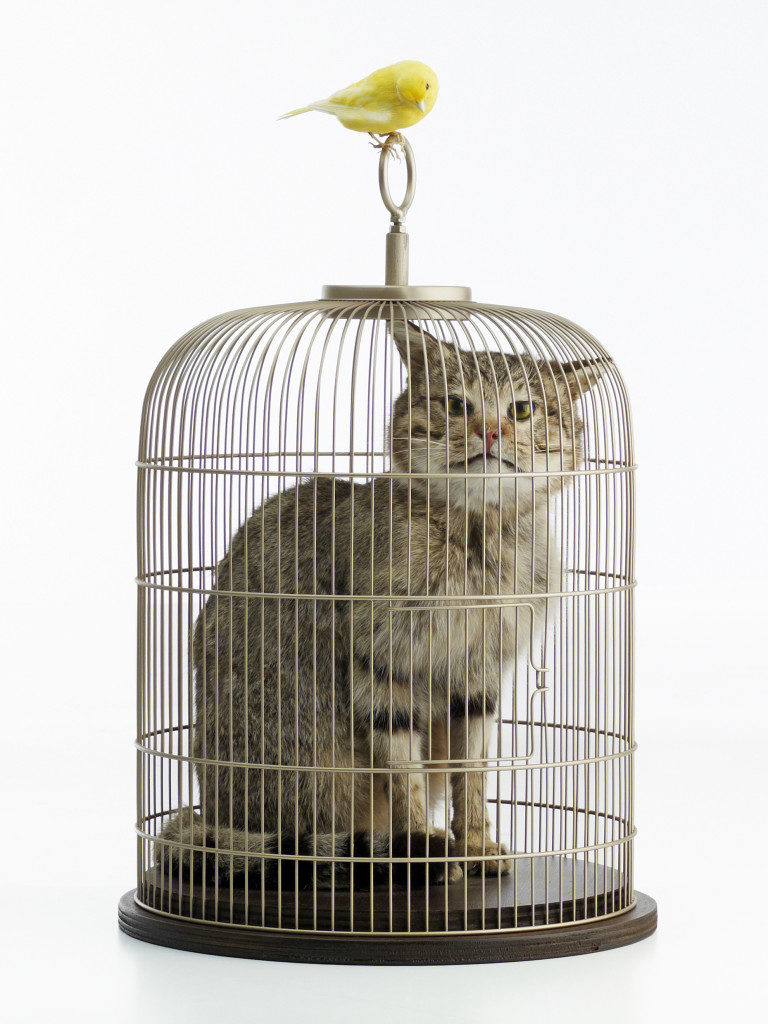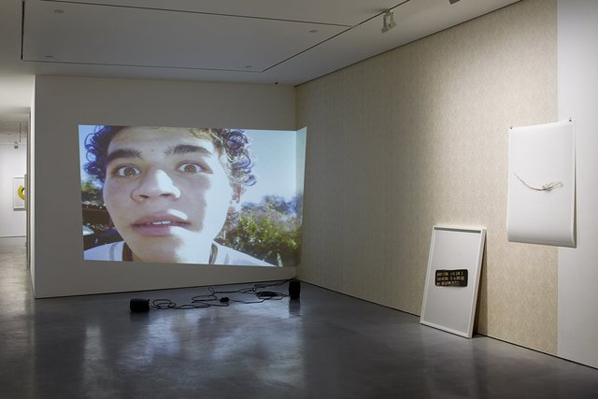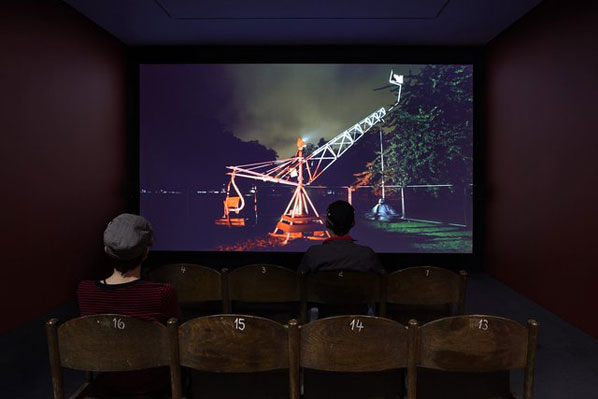



Anonymous, untitled, dimensions variable is the title of a show by 0100101110101101.ORG (Eva and Franco Mattes) at Carroll/Fletcher gallery in London from 13th April to 18th May 2012. Or at least it was. The title changes each day based on submissions to a blog (http://exhibitiontitlechange.tumblr.com/). The new titles have been printed out and displayed on the wall to the left as you walk in to the gallery.
You don’t expect this kind of playful intersection of the virtual and the real in a gallery off of Oxford Street, across from Soho, opposite other new galleries. Carroll/Fletcher’s glass-fronted welcomingly brutalist interior says “serious contemporary art space”. Inhabiting such a space presents a challenge to net and digital art that must be met with careful presentation and considered curation.
Through the glass front of the gallery, and as you enter, you see a sculpture or assemblage of a (stuffed) cat trapped in a birdcage by a (stuffed) canary (Catt, 2010). The cat has suffered Epic Fail as the Internet would say, and did in the meme image that the sculpture is based on. It’s a comic and unnerving object even without the extra layers of reference provided by the original meme and the knowledge that it was originally presented as a fake Maurizo Cattelan sculpture. It is art with its roots in the net that can stand on its own without that context. Its companion piece, Rot, 2011, is a fake Dieter Roth sculpture consisting of detritus in a glass jar on a plinth against the far wall. 0100101110101101.ORG briefly inserted it into the Wikipedia page on Roth, and the fact that its materials were all ordered via the Internet drives home just how commonplace this has become.

Both are given the room they need to work as objects in a gallery. Neither originates in itself as net art, more in 0100101110101101.ORG’s history of tricksterism and transgression. These are concerns that are easily linked to net culture, possibly too easily on the part of the reviewer, but it is telling that they are the works that the show opens with. They physically establish the playful appropriation and hyperreality that is the basis of much of 0100101110101101.ORG’s work.
Pride of place in the first room of the gallery goes to the projection The Others, 2011, 10,000 digital photographs (supposedly) copied without authorization from the folders of computers used by people on a peer-to-peer filesharing network that 0100101110101101.ORG used to distribute their own work. These are private images, projected at an angle and slightly across the corner. Configure your peer-to-peer filesharing client wrongly and it shares all the files in the folder you share. Including the images of you naked, drunk, lonely, partying, or whatever else you wouldn’t post anywhere a future employer might find them.

In the next, smaller, room is Colorless, odorless and tasteless, 2011. It is an old-fashioned car racing video arcade game retro-fitted with a petrol engine that starts up when you insert a coin and revs as you press the pedal to accelerate the virtual car on the screen, filling the (sealed…) room with carbon monoxide. Combining the virtual made physical of Catt and the moral impact of The Others, it is the most immediately dangerous artwork I’ve ever had to review.
Moving into the larger room at the back of the ground floor of the gallery, the video No Fun, 2010, is the most shocking piece in the show. Franco Mattes pretending to hang hineself on the random Internet webcam video chat switchboard Chatroulette is one thing, but the reactions of other Chatroulette users as they connect and see him apparently hanging there is quite another. Some laugh, some jeer, only one I watched displayed any lasting concern. This is the moral and aesthetic flipside of The Others.
Reenactments, 2007, is my aesthetic and technical favourite piece in the show. Videos of canonical performance art pieces being re-enacted by Eva and Franco’s Second Life avatars are displayed on CRT monitors arranged at floor level surrounded by the cables and adapters used to play back the video from SD cards. It’s much easier for an avatar to remain still as a “Singing Sculpture” than it is for a human being, making it even stranger, and Marina Abramovic’s “Imponderabilia” works much better with impossibly buff avatars than with mere naked human models stood in a doorway. It exquisitely foregrounds the social mediation of Second Life and its players self-presentation. A large cartoon wolf squeezes through between the naked avatars, their polygons intersecting. A vampire attempts to fly over them but hits the bounds of the architecture. The crowd in the background chat and bide their time. The virtual intensifies the real, out-doing and critiquing its appropriated source material.

Stolen Pieces, (1995, made public 2010) claims to move beyond fakery and unauthorized copying to physical appropriation. Stolen physical fragments of canonical postmodern artworks (Duchamp, Warhol, Koons, Rauschenberg) are displayed like forensic evidence, protected in small plexiglass containers, accompanied by large photographs of them and by documentary evidence of their theft. There’s no statute of limitation on theft in the UK, and damaging artworks shouldn’t be applauded. But it’s a daring performance and a concrete critique of the fetishism that lies at the heart of the art market and the institutions that help drive its value.
Following the brutalist concrete staircase to the basement reveals My Generation, 2010, a smashed but still working early-2000s PC lying on the floor. On its monitor, that appears to have fallen on its side, show video clips of computer game players giving in to and venting their frustration at the games they play. This isn’t the kind of image of yourself you want as your lasting monument on the Internet. Gathered together, like the images in The Others and the videos in No Fun, they again form a summation of an aspect of society and our visual environment that could not be achieved with such immediacy by other means. And the clear space and architectural solidity of the gallery again help to put a different emphasis on the material than if it was encountered on the web.
The wall-filling video projection of Freedom, 2011, records Eva’s attempts to plead with the players of networked First Person Shooter computer games not to kill her character. Touch-typing might have helped, but even when Eva manages to type long enough to explain that she’s an artist, or to ask people not to shoot, the social and game logic of the virtual world mean that her character is executed again and again, the screen shifting to third person as her avatar moves out of her control in death. Like No Fun, there is a core of callousness to these Internet interactions, and like My Generation they are unexpectedly preserved and presented for contemplation.
The final piece in the show is the documentary Let them believe, 2010, a video record of 0100101110101101.ORG’s Tarkovsky-haunted journey into Chernobyl’s “Exclusion Zone” in order to recover part of a fairground ride to turn into Plan C, 2010. Bringing part of the ride to life in a place where people can enjoy it is an effective and resonant symbolic resolution of the kind that art more than any other mode of human endeavor can provide.

0100101110101101.ORG’s work presented physically has more than enough presence to fill the gallery and benefits from the space and the considered curation afforded it here. Some of the work is more physical than virtual and vice versa, sometimes the ethics of the work place 0100101110101101.ORG as the villain sometimes as the victim, and sometimes the work is performance whereas other times it is assemblage. I mention this to point out both the strong themes to the work and how individual the effect of each piece is.
Net art in the gallery might seem a category error, like museum postal art. Or it might seem a commodity, like auctions of land art documentation. But net art is transitioning from being the contact language of artworld emigrants learning the net’s protocols to the contact language of net emigrants learning artworld protocols. 0100101110101101.ORG have made art of these encounters from the start, and have always been as at home in the gallery as on the net.
The text of this review is licenced under the Creative Commons BY-SA 3.0 Licence.